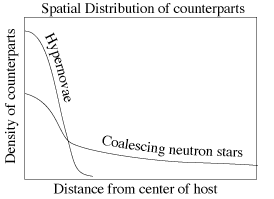What are the Progenitors of Gamma Ray Bursts?
Three parameters are needed to determine the origin of GRBs are:
- total energy released
- nature of the host galaxy
- location within the galaxy
The Swift mission is optimized to measure these three parameters for many hundreds of bursts.
Obtaining the total energy released requires a reliable distance to the burst, so that the obesrved flux can be converted to the intrinsic luminosity of the burst. The distance can be obtained from the measured redshift. Ideally the redshift should be measured independently for both the afterglows and any host galaxy to check that the afterglow is actually located in the galaxy and that there has not been a chance positional coincidence. This is a major concern since some host galaxies may be very faint (>26th magnitude).
The sub-arcsecond localizations obtained by Swift are used by ground-based observatories to take optical and infrared spectra of the afterglow. Spectral lines due to absorption or emission in the host galaxy, as well as line produced in the immediate environment of the burst, can provide high-precision redshifts, and thus distances, for these bursts. For the brightest optical afterglows (those brighter than mB ∼ 15)) this can be done onboard Swift using the UVOT's optical and ultraviolet grisms. In cases where spectra can not be obtained a photometric redshift can be estimated using multi-filter UVOT photometry to constrain the wavelength of the Lyman-alpha break.
Swift Field-of-View compared with Hubble Deep Field

Hubble deep field image: The green (larger) circle, denotes the five arcsecond XRT error circle for an X-ray afterglow. Notice that there is a galaxy inside the error circle. The yellow line points to the much smaller (0.5 arcsecond) UVOT error circle (yellow), which pin-points the site of the gamma-ray burst. The purple line gives the scale of the image. The XRT position indicates the likely host galaxy and the UVOT determines the location of the burst within the galaxy.
The UVOT obtains ∼0.5 arcsec positions by using foreground stars to register the field. This provides a unique host galaxy identification and is also sufficient to allow a comparison with images from other telescopes, such as HST, to determine the offset of the burst from the nucleus of the galaxy.
About 40% of Swift-detected gamma-ray bursts do not have a UVOT afterglow. The reason for this is an active area of research, but in many cases it is due to extinction from dust surrounding the site of the burst. In these cases the XRT position usually enables the unique identification of a host galaxies. Follow-up observations with Chandra then provides sub-arcsecond positions for these bursts.
Progenitors from Positions

Spatial distribution of counterparts: The horizontal axis is the distance from center of host. The vertical axis is the density of counterparts. Starting high on the vertical axis a line labeled "Hypernovae" drops steeply to the horizontal axis. Half way up the vertical axis a line labeled "Coalescing neutron stars" gently slopes down and then runs the length of the graph. Hypernovae occur in star-forming regions. Neutron star pairs have the lifetime and velocity needed to escape their original host galaxies.


